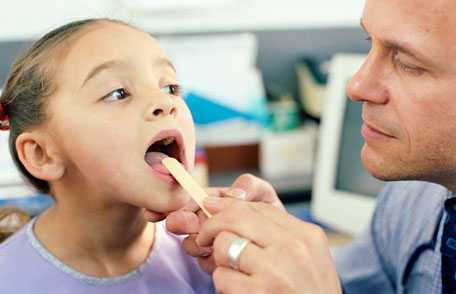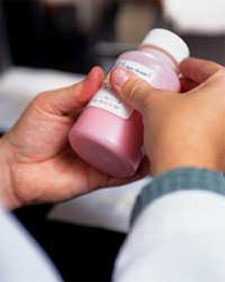Scarlet Fever: A Group A Streptococcal Infection
 Scarlet fever results from group A strep infection. If your child has a sore throat and rash, their doctor can test for strep. Quick treatment with antibiotics can protect your child from possible long-term health problems.
Scarlet fever results from group A strep infection. If your child has a sore throat and rash, their doctor can test for strep. Quick treatment with antibiotics can protect your child from possible long-term health problems.
Scarlet fever – or scarlatina – is a bacterial infection caused by group A Streptococcus or “group A strep.” This illness affects some people who have strep throat or skin infections caused by group A strep. It is usually a mild illness, but people with scarlet fever need treatment to prevent rare but serious health problems. Doctors treat scarlet fever with antibiotics to help clear up symptoms faster and reduce spread to other people.
Although anyone can get scarlet fever, it usually affects children between 5 and 15 years old. The classic symptom of the disease is a certain type of red rash that feels rough, like sandpaper.
Scarlet Fever Podcast
A pediatrician explains the cause, treatment, and prevention of scarlet fever. Listen or download [5:09 minutes]
How Do You Get Scarlet Fever?
Group A strep bacteria can live in a person’s nose and throat. The bacteria spread through contact with droplets from an infected person’s cough or sneeze. If you touch your mouth, nose, or eyes after touching something that has these droplets on it, you may become ill. If you drink from the same glass or eat from the same plate as the sick person, you could also become ill. People can get scarlet fever from contact with sores from group A strep skin infections.
Common Symptoms of Scarlet Fever
- A very red, sore throat
- A fever (101° F or above)
- A red rash with a sandpaper feel
- Bright red skin in underarm, elbow, and groin creases
- A whitish coating on the tongue
- A “strawberry” (red and bumpy) tongue
- Headache or body aches
- Nausea, vomiting, or abdominal pain
- Swollen glands
Scarlet Fever: What to Expect
Illness usually begins with a fever and sore throat. There also may be chills, vomiting, and abdominal pain. The tongue may have a whitish coating and appear swollen. It may also have a “strawberry”-like (red and bumpy) appearance. The throat and tonsils may be very red and sore, and swallowing may be painful.
One or two days after the illness begins, the characteristic red rash appears (although the rash can appear before illness or up to 7 days later). Certain strep bacteria produce a toxin (poison) that causes some people to break out in the rash—the “scarlet” of scarlet fever. The rash may first appear on the neck, underarm, and groin (the area where your stomach meets your thighs), then spread over the body. Typically, the rash begins as small, flat red blotches that gradually become fine bumps and feel like sandpaper.
Although the cheeks might have a flushed appearance, there may be a pale area around the mouth. Underarm, elbow, and groin skin creases may become brighter red than the rest of the rash. Doctors call these Pastia’s lines. The scarlet fever rash generally fades in about 7 days. As the rash fades, the skin may peel around the finger tips, toes, and groin area. This peeling can last up to several weeks.
Doctors treat scarlet fever with antibiotics . Many viruses and bacteria can cause sore throats. Ask the doctor about getting a strep test if your child has a sore throat. A strep test involves swabbing the throat to see if group A strep is causing the illness. If the test is positive, your child’s doctor will prescribe antibiotics. Antibiotics help someone with scarlet fever feel better sooner and protect others from getting sick.

It is important for anyone with a sore throat to wash his or her hands often.
Long-term Health Problems from Scarlet Fever
Long-term health problems from scarlet fever may include:
- Rheumatic fever (an inflammatory disease that can affect the heart, joints, skin, and brain)
- Kidney disease (inflammation of the kidneys, called post-streptococcal glomerulonephritis)
- Otitis media (ear infections)
- Skin infections
- Abscesses (pockets of pus) of the throat
- Pneumonia (lung infection)
- Arthritis (joint inflammation)
Treatment with antibiotics can prevent most of these health problems.
Preventing Infection: Wash Those Hands
The best way to keep from getting infected is to wash your hands often and avoid sharing eating utensils, linens, towels, or other personal items. It is especially important for anyone with a sore throat to wash his or her hands often. There is no vaccine to prevent scarlet fever. Children with scarlet fever should stay home from school or daycare for at least 24 hours after starting antibiotics.
Antibiotics: Bacteria-Busters
 Group A strep is a type of bacteria commonly found in people’s throats and on their skin. Group A strep can cause a range of infections, from a sore throat (strep throat) to skin infections (impetigo). Rarely, it can cause very dangerous, deadly infections.
Group A strep is a type of bacteria commonly found in people’s throats and on their skin. Group A strep can cause a range of infections, from a sore throat (strep throat) to skin infections (impetigo). Rarely, it can cause very dangerous, deadly infections.
The word antibiotic comes from the Greek words anti meaning ‘against’ and bios meaning ‘life.’ Some people call antibiotics antibacterials. Doctors use antibiotics to treat infections caused by bacteria, such as scarlet fever or whooping cough.
Antibiotics target only bacteria. They do not attack fungi or viruses, which cause infections like athlete’s foot or the common cold. If you or your child has an infection, it’s important to know the cause and follow the right treatment. Improper use of antibiotics has resulted in many bacteria becoming resistant to antibiotics.
- Page last reviewed: January 17, 2017
- Page last updated: January 17, 2017
- Content source:
- National Center for Immunization and Respiratory Diseases, Division of Bacterial Diseases
- Page maintained by: Office of the Associate Director for Communication, Digital Media Branch, Division of Public Affairs




 ShareCompartir
ShareCompartir